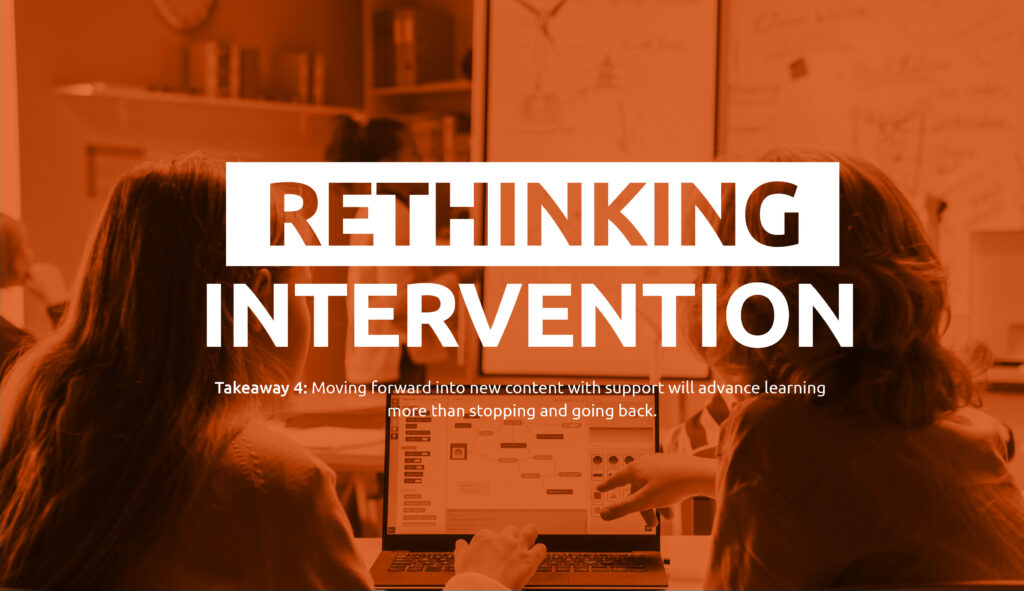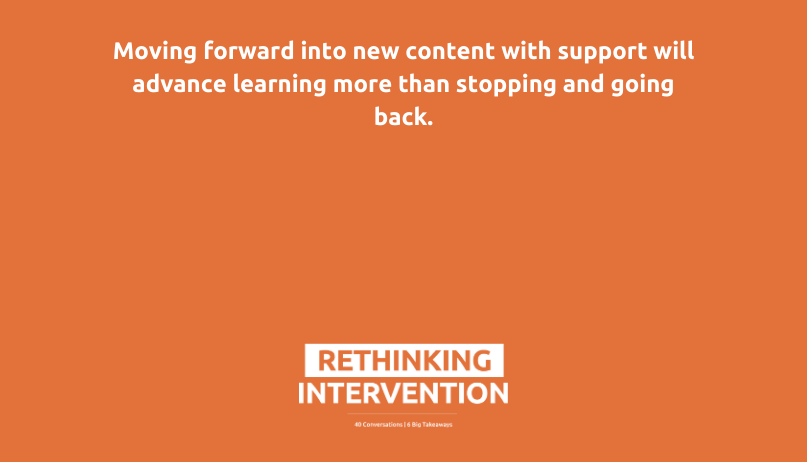
Advancing Learning
Moving forward into new content advances learning more than going back
By Emily Freitag
This post is adapted from an email originally shared on February 26, 2021. If you would like to receive future emails from Emily Freitag, you can sign up here.

Access the Takeaway 4 PLC reflection and discussion guide.
Every school I have ever visited has a poster on a wall somewhere that says “You miss 100% of the shots you never take.” If the posters we choose communicate the values we encourage, then we as educators want our students to be bold, give it a go, and take a risk.
Yet, educators’ instructional mantras often express a different set of values. With nothing but the deepest desire to help students, when talking about what to teach I often hear educators say things like “I need to meet students where they are” or “we have to crawl before we can walk” or “I want to set them up for success.”
I blame Vygostky; something about that visual of the zone of proximal development is so sticky (and so easily misunderstood). Or maybe it is our learning metaphors: roads, paths, dominoes. Or maybe it is the way we talk about standards and assessments: “I have to give an assessment so I know what students know, then I can go back to check off the things they don’t know.”
I wish these ideas were right — we’d have an easier job! But alas, learning is complex, and what works in one case may not work in another. Educators have always had burning questions about how to best support diverse learning needs. It feels even more urgent now to be able to lean on the best of what we know about supporting a broader range of entry points after a year of bumpy and often frustrating schooling.
So, what do we know? I walked away from the Rethinking Intervention conversations clear on two things:
- The structure of learning in each discipline shapes how we need to think about the approach to unfinished learning in that discipline.
Let’s look at science, math and literacy.
The whole discipline of science is based on the idea that our learning is always unfinished; there is always more to know. We want to constantly position students to ask questions about the world around them that reveal what they can’t yet explain and then engage in scientific practices and apply crosscutting concepts to answer the questions.
Math involves columns of big ideas that build and connect. Within any given concept there is room to connect it to other concepts (which makes math so beautiful!), but some concepts are load-bearing walls to the next level. In general, we can push forward in math, but we need to understand which concepts are most important to the specific topic we are teaching and reinforce those as we advance. Even if it is essential to the learning, we can reinforce base 10 place value concepts as we teach double digit subtraction.
Literacy includes distinct components that need to be thought about differently. Foundational skills (how students learn to read) are the most sequential of all the disciplines. For example, students cannot decode multisyllabic words if they cannot first decode a monosyllabic word. There are risks if the sequence of instruction is broken because the skills progressively build upon one another. Comprehension (how students read to learn and express themselves) requires a reader to create a mental picture of what they are reading, building a 3D puzzle out of knowledge of the text’s topic, understanding the vocabulary in that text, and developing analysis and communication skills. There are no prerequisites required to dig into the next text or unit — missing the unit on human rights does not prevent a student from engaging in a unit on innovators.
- If we have to choose between going back to review or pushing learning forward, we should push forward. The theme across conversations was so clear: being ready for the “just in time” reinforcement of only the most important concepts will lead to more learning than staying in the “just in case” zone. In particular, the findings from our colleagues in higher education about the value of the co-requisite rather than the prerequisite models point to how bias and faulty perceptions about student potential (see Takeaway 2) can negatively affect choice points that ask us to sort students into tracks, and how many learning benefits come from creating forward momentum, leveraging strengths, and honoring student capability.We tell students, “You miss 100% of the shots you never take.” As educators, we need to tell ourselves, “Students will miss 100% of the shots we do not ask them to take.”
Here are a few resources relevant to this takeaway:
- EdResearch for Recovery published this brief to answer the question: Which areas should schools prioritize for intensive academic intervention and what strategies are most effective?
- This document from NGSS outlines the progression of disciplinary core ideas across grade bands, while highlighting the core science ideas of the standards.
- The coherence map from Student Achievement Partners illustrates how the math standards are related and includes a sample task for each standard.
- This report from Student Achievement Partners examines the research base for literacy accelerators, as well as the intersections for equitable personalization.
- This article from Inside Higher Ed digs into the evidence on the effectiveness of co-requisite approach to unfinished learning.
What else would you add? I’d love to hear your thoughts by email or through our social channels using #RethinkingIntervention.


